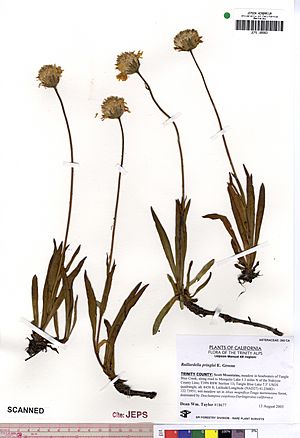Showy raillardella facts for kids
Quick facts for kids Showy raillardella |
|
|---|---|
 |
|
| Conservation status | |
| Scientific classification | |
| Kingdom: | |
| (unranked): | |
| (unranked): | |
| (unranked): | |
| Order: | |
| Family: | |
| Genus: | |
| Species: |
R. pringlei
|
| Binomial name | |
| Raillardella pringlei Greene
|
|
Raillardella pringlei is a rare flowering plant. People often call it the showy raillardella. It belongs to the daisy family. This plant is special because it only grows in one place. You can find it in the southern Klamath Mountains of northern California. It likes to grow in wet forest areas. It especially likes a unique type of ground called serpentine soil.
Contents
About the Showy Raillardella
The showy raillardella is a plant that lives for many years. It grows from underground stems, like some grasses. This helps it spread and form a small group of plants. Its leaves grow in a circle close to the ground. These leaves are long and thin, like a spear. They can be up to 15 centimeters long. Their edges are usually smooth, but sometimes they have tiny teeth. The leaves are mostly smooth and do not have much hair.
What the Flowers Look Like
The plant grows a tall stem with flowers on top. This stem can be from 25 centimeters to half a meter tall. It usually has one flower head, but sometimes it can have up to three. The flower head looks like a bell. It can be wide and open.
Flower Colors and Parts
Each flower head has many small flowers inside. These are called disc florets. They are bright orange to reddish-orange. Each one is about one centimeter long. Around the edge of the flower head, there are longer petals. These are called ray florets. They are also orange or reddish. Each ray floret can be up to 2 centimeters long.
Seeds and How They Spread
After the flowers bloom, the plant makes seeds. These seeds are long and narrow. They are called achenes. Each seed can be up to 2 centimeters long. This length includes a special feathery part. This part is called a pappus. It looks like a plume of bristles. The pappus helps the seeds float in the wind. This allows them to travel to new places.


